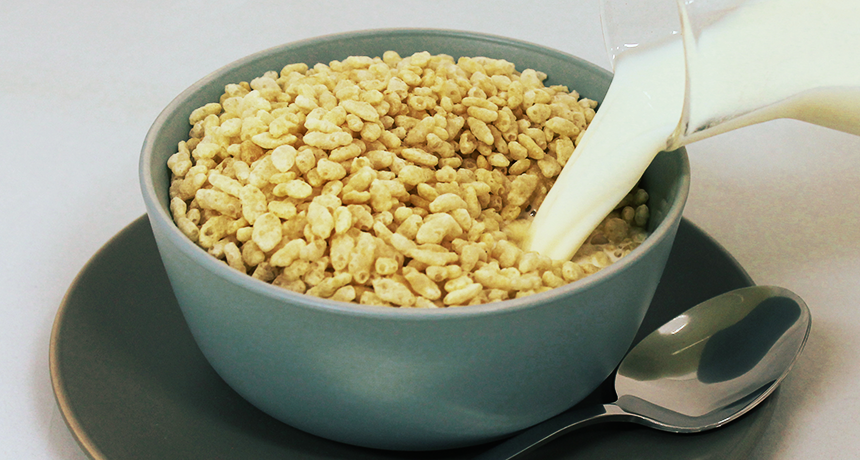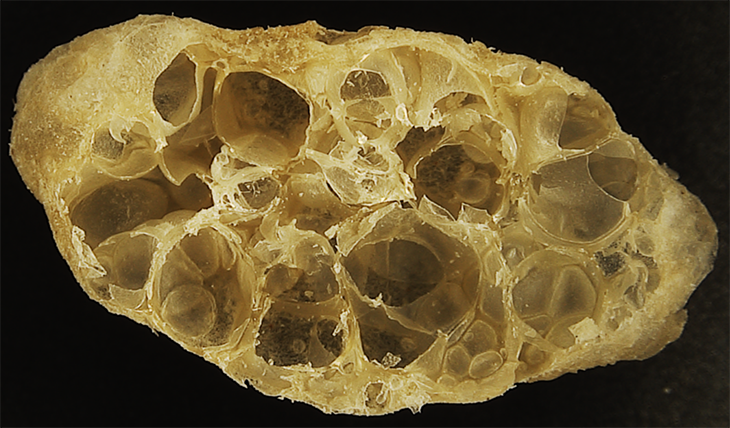Soggy cereal gives clues to how rock dams collapse
Cereal ‘ricequakes’ could help scientists predict when bigger structures will fall

What does your breakfast have to do with a giant dam or a river of ice? Quite a bit, a new study finds.
I. Einav and F. Guillard
A bowl of rice cereal might seem like it has nothing in common with a huge rock dam or an Antarctic ice sheet. But look a little closer. When puffed rice is poured into milk and pressed down, liquid creeps into the cereal. The rice then sinks into the liquid with a large crash. At this point, a slow creep begins again. Those crashes — called ricequakes — happen at regular, predictable times, a new study finds. And the snap, crackle and pop of Rice Krispies soaking in milk can help scientists understand how larger things fall apart, such as huge ice sheets or heaps of rocks.
Itai Einav works in Australia at the University of Sydney. Technically, he is an engineer who studies granular materials. And those can be anything from rocks and sand to flour. But these days, you might call him a cereal scientist. “I worked for several years on dry Rice Krispies with a colleague,” he explains.
They did a series of studies, just looking at how it crushes. And then, they realized, “There was a connection to rocks.” The patterns that emerge when you crush the cereal, he says, “are strikingly similar.”
Science with cereal alone will soon run dry, however. So he and Francois Guillard poured puffed rice cereal into a tube filled with water or milk. (Puffed rice cereal is called Rice Krispies in the United States but Rice Bubbles in Australia.) The pair then added a weight on top. At 3 kilograms (6.6 pounds), that weight was about as heavy as a very thick book. “We know what happens when you add milk without pressure; everyone’s done it at home,” Einav says. Pressing down on the cereal would better imitate a heavy rockfill dam, he and Guillard suspected.
Those dams are large hills of rocks and dirt. They’re cheap to make because they don’t need concrete or other expensive materials. Dirt and rocks can be found anywhere. What’s more, these dams won’t crack — as concrete might — when an earthquake hits. Rockfill dams are important structures. They hold back water to create big reservoirs. Controlled spills of water from some of them provide electrical power. Other dams might keep chemical wastes from mines or other operations from spilling into the environment.
But unlike dams made of concrete (like the Hoover Dam), those made from rocks and earth have holes. Even the most solid rocks have tiny, tiny holes in them, Einav explains. “Rocks without holes don’t exist.” There are also air pockets between the rocks and dirt clumps.

Over time, water can creep into such air spaces. It soaks upward from the bottom of the dam toward the top through a process known as capillary action. The soaked material begins to sink. It can even collapse. In 1998, a rockfill dam collapsed in Aznalcóllar, Spain. This spilled tons of dangerous mine wastes into a local river.
Einav and Guillard decided to build a puffed-rice model that might help them predict when a large rockfill dam might come crumbling down. They watched their weighted, wet cereal carefully. They also took video and recorded sounds this cereal produced.
Creep and crash
Rice cereal collapses into liquid in two distinct, repeating phases, the researchers found. In the “creep” phase, milk or water soaked upward. It entered into the air holes inside the rice and between the cereal grains. Meanwhile, the weight that the scientists had placed on top pressed the dry cereal down from above. This made small crackling noises as the rice got crushed.
When the downward pressure became too great, the soaking cereal underwent a ricequake. All at once, the cereal shifted downward with an audible snapping sound. It was far louder than the previous crackles.
Hear the snap and crackle, and the louder pops? This is the two-stage collapse of puffed rice under pressure. Audio: I. Einav and F. Guillard
This cycle repeated over and over. By observing the puffed rice, the scientists were able to predict a steady pattern.
As cereal sinks into bowl of milk, those ricequakes occur at longer and longer intervals. The cereal might appear to smoothly sink into the milk. In fact, the process was really a series of creeps and crashes, the scientists found. The same thing happens when a rockfill dam fails, Einav notes. The disaster may seem to happen all at once, but actually “it’s made of small collapse events.” And those control how quickly a dam fails, he says.
The new results might apply to more than rockfill dams. After modeling ricequakes, Einav heard about “icequakes.” These are masses of ice that shift and slide as melted water soaks up from below. “They happen twice daily in Antarctica,” Einav says.
He and Guillard compared their model to a moving stream of ice in Antarctica called the Whillans Ice Stream. The ice streams, they found, move in very similar ways to their puffed rice and milk.
“Once we have the model and equations, we can play with it and imagine what happens” as ice streams shift, Einav says. The team published its results October 12 in the journal Science Advances.
Kerstin Nordstrom really likes their team’s “idea of making a scaled-down model” and tracking the collapses with sound. She is a physicist at Mount Holyoke College in South Hadley, Mass. It’s “a neat way to understand the mechanics going on inside a material when you can’t see inside it,” she says. Scientists use sound to track earthquakes, for example.
The math that Einav used to model sinking cereal could definitely apply to rockfill dams, adds Yida Zhang. He’s an engineer at the University of Colorado in Boulder who studies such dams. It’s relatively easy to know if a dam will collapse, he says. When it will collapse is harder to predict. The humble breakfast cereal might help people predict such disasters before they happen, he says.
“I’m not trying to save the world with Rice Krispies,” Einav notes. He’s just passionate about watching material collapse — whether that’s an ice sheet or a bowl of cereal. He knew some collapse would happen in his experiment, he says. But finding a regular, organized series of ricequakes? “It was so glorious and beautiful.”







